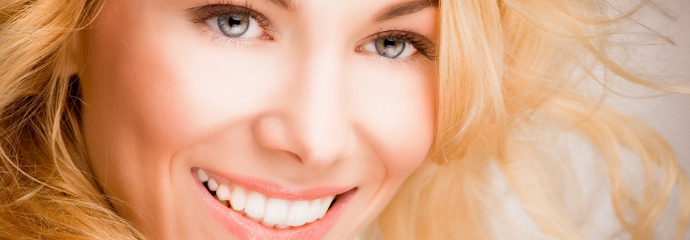You are here
What constitues a beautiful smile

How can we define what a beautiful smile is supposed to look like? It seems that the definition can vary vastly from one era to the other. However, generally speaking, a more 'youthful' smile is usually considered more attractive and desirable.
Recent studies and investigations have shown that the current trend seems to encompass, ideally, the following characteristics:
- when producing a full smile, the lower border of the upper lip should rest just around the gingival (gum) border of the upper teeth, +/- 1mm.
- the lower borders of the upper teeth should also form a convex curvature that follows the contour of the upper border of the lower lip and sitting above it. The tip of the upper canines may be barely touching the lower lip.
- the lower lip should be curving upward and backward to the corner of the mouth, where it meets the upper lip.
- the width of the upper anterior teeth should ideally be in a certain ratio, when viewed from the front, while comparing the central incisor, the lateral incisor and the canine. It is not the absolute size that matters. Proportion is the key. The golden proportion is currently recognised as 1.618 : 1.0 : 0.618.
- the long axis of the upper anterior teeth should also follow a particular ratio and progression in its inclination, when viewed from the front.
- the gingival margin of the upper lateral incisors should be on par or lower than that of the upper central incisors, while the upper canines and the upper central incisors should be at the same level.
- the midline between upper central incisors should be straight, being perpendicular to the interpupillary line and coincide with the facial midline.
- the contact area between two adjacent teeth should be broad instead of merely a small point. The contact area can range from 30%-50% of the crown length, depending on the site.
- the upper arch should be as wide as genetically possible, with upper posterior teeth being upright, so that there is no dark space in the buccal corridor (ie. towards the corners of the mouth).
- teeth with lighter shades, eg. A1, A2, B1, B2, will create a more youthful impression than darker shades.
- there should be no wearing down of the incisal edges of the anterior teeth.
- for females, the incisal tip of the upper canines should be slightly rounded and the lateral incisors have a more rounded incisal contour; while in males, the canines should be more pointy and the lateral incisors with a flatter incisal contour.
- when at rest, lower teeth should not be visible while the incisal (biting end) 1.5-3.5mm of the upper teeth should be showing through below the lower border of the upper lip.
- and of course, balance and symmetry of the left and the right (teeth & arch).
As not everybody is lucky enough to be born that way, modern dentisty techniques, such as orthopaedic orthodontics, fixed orthodontics, teeth whitening, crowns, veneers and composite buildups, can be used to enhance what nature has given you. These techniques may be used alone or in combination to create the best possible and most naturalistic smile for you, ideally to fit the philosophical triad of "health, function and beauty".
Our Doctors
Opening hours
- Monday: 9am–5pm
- Tuesday: 9:30am–6pm
- Wednesday: 9am–5pm
- Thursday: 9am–5pm
- Friday: 9am–5.30pm
- Saturday: 9am–1pm
- Sunday: Closed

